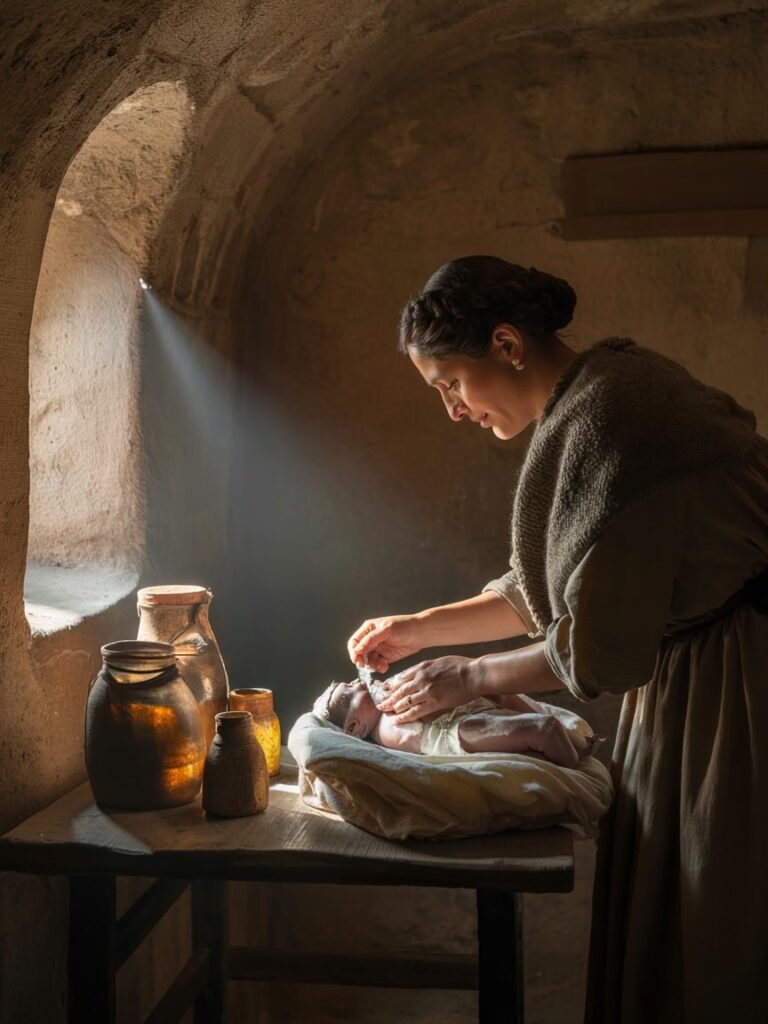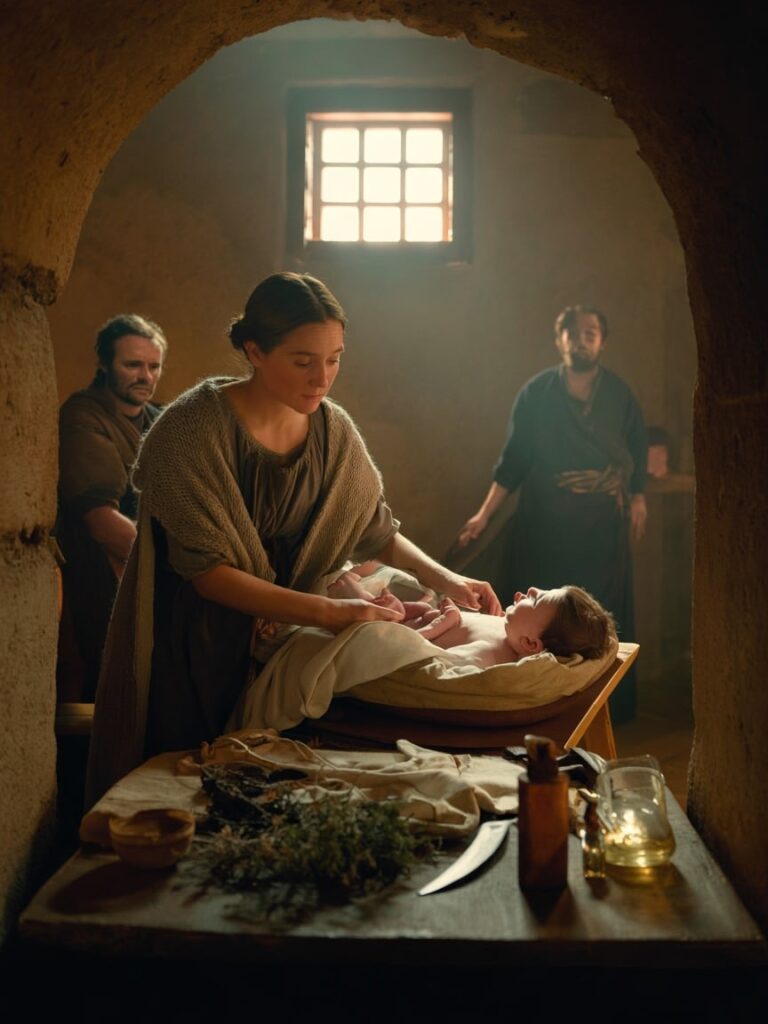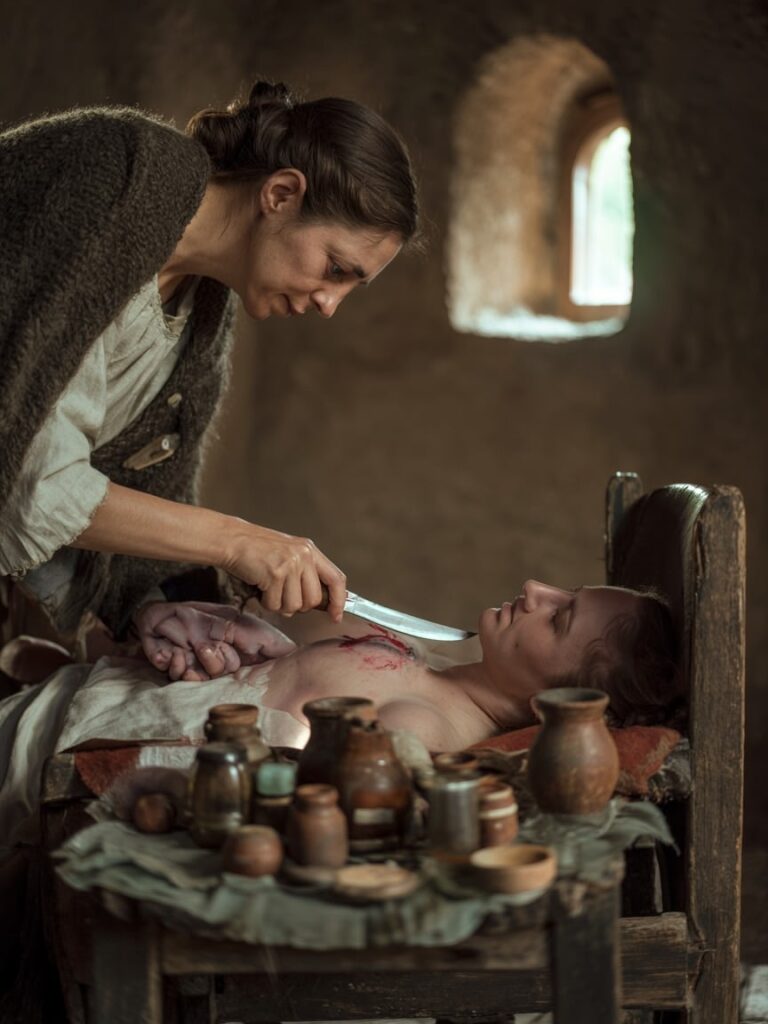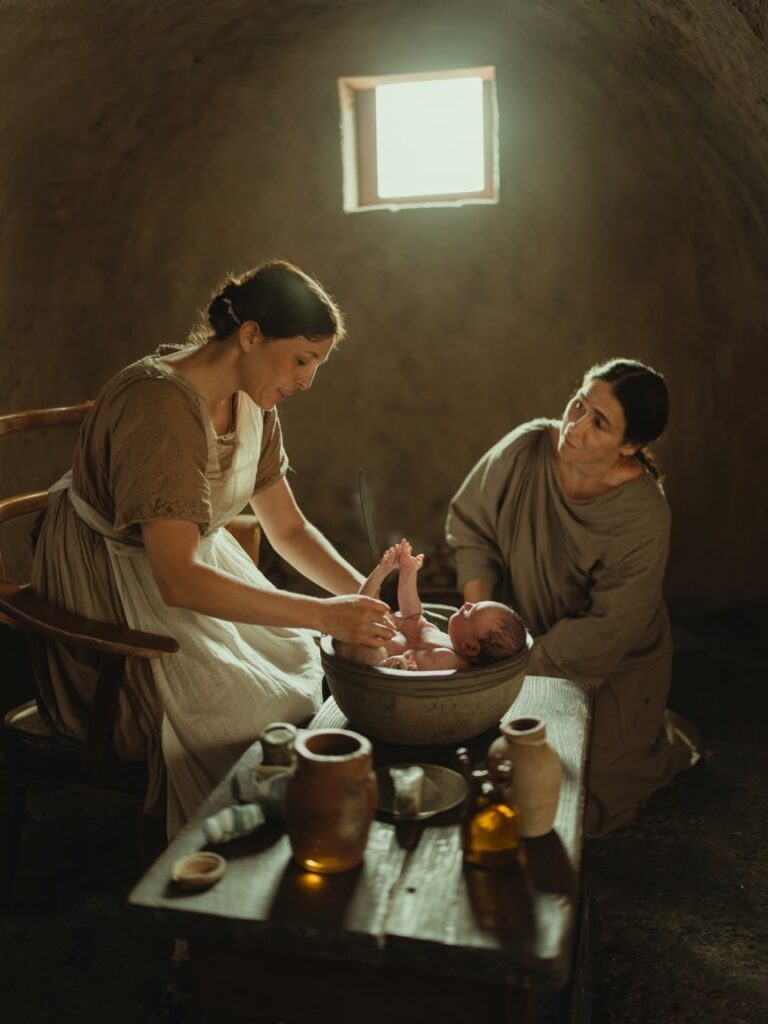Roman midwives were crucial in ancient healthcare, particularly in assisting with childbirth. Their knowledge and skills greatly impacted the experiences of many women during pregnancy and delivery, yet their contributions are often overlooked in history.
These midwives did more than just help women give birth; they were trusted caregivers whose abilities went beyond the delivery room. They handled complicated births and promoted the health of mothers and infants, playing a vital role in both areas.
This article explores The Forgotten Role of Roman Midwives in Ancient Healthcare, shedding light on their diverse contributions to women’s health and childbirth. It examines how these women combined practical medical expertise with empathetic care, shaping early reproductive healthcare systems in ways that are seldom acknowledged today.
To fully appreciate the importance of midwives, it’s essential to view their role within the larger context of ancient Roman society. During a time characterized by political instability and weak leadership, these midwives offered families a sense of stability and support amidst turmoil.
Furthermore, the trade and economy during this era significantly influenced the resources and tools accessible to midwives, thereby enhancing their capacity to deliver care.
Additionally, exploring the Roman Pantheon provides insight into the cultural beliefs surrounding childbirth and women’s health at that time. The gods worshipped reflected societal values that often shaped attitudes and practices related to pregnancy and childbirth.

The Role of Roman Midwives in Childbirth
Roman midwives played a crucial role in assisting childbirth, guiding women through labor and delivery. Their knowledge went beyond just being there; they actively managed birth practices that could determine whether the mother and child lived or died.
They often dealt with complicated deliveries, using their experience and practical skills to handle problems without modern medical technology. Midwives evaluated how labor was progressing, helped position the mother, and used methods like supporting breech births or facilitating delivery when natural processes struggled.
Tasks Performed by Midwives
Specific tasks performed by midwives included:
- Severing the umbilical cord carefully once the newborn arrived, a critical moment requiring precision to prevent infection or harm. This task, as detailed here, was often a delicate process.
- Bathing and cleaning the newborn immediately after birth, ensuring early hygiene.
- Monitoring the newborn’s initial health signs to determine vitality.
- Advising mothers on immediate post-delivery care to promote recovery, which included care of the baby in the delivery room.
Their role was hands-on and deeply involved in every stage from labor onset through delivery completion. Roman midwives were not simply attendants; they were skilled practitioners entrusted with safeguarding both maternal and infant well-being during one of life’s most vulnerable moments.

Midwives Beyond Delivery: Maternal and Infant Aftercare
Roman midwives extended their care well beyond the moment of birth, playing a vital role in postpartum care for both mothers and infants. They monitored the physical recovery of new mothers, offering advice on hygiene, nutrition, and rest to ensure optimal healing after childbirth. Their expertise helped prevent infections and complications during this vulnerable period.
Infant care advice was another essential aspect of their duties. Midwives guided mothers on breastfeeding techniques, newborn hygiene, and early childhood health practices. They also made recommendations about wet-nurses when necessary, often preferring Greek wet-nurses known for their sobriety and moderation.
In addition to practical care, midwives provided emotional support, reassuring mothers through the challenges of early motherhood. This holistic approach combined medical knowledge with compassionate guidance, reinforcing the midwife’s role as a trusted caregiver throughout the critical postpartum phase.
Interestingly, the role of midwives in ancient Rome is just one aspect of a larger societal structure where various professions held significant influence. For instance, the use of coins as propaganda by emperors illustrates how even currency was leveraged to convey authority and legitimacy. These small pieces of currency went beyond their basic purpose and became significant instruments for political messaging.

Reproductive Health and Medical Practices: The Comprehensive Role of Roman Midwives
Roman midwives played a crucial role in managing reproductive health beyond just assisting with childbirth. Their responsibilities included:
1. Providing contraception
Midwives offered various contraceptive methods, often using herbal remedies. These natural treatments aimed to prevent pregnancy, reflecting practical knowledge rooted in local traditions.
2. Performing abortions
Abortion was a recognized practice in ancient Rome, with midwives skilled in administering safe procedures using botanical preparations. Documentation from Pliny the Elder highlights several herbs and compounds employed by midwives for this purpose.
3. Use of reproductive health remedies
Remedies were tailored to address a range of gynecological issues. Midwives combined empirical knowledge with accessible resources to treat conditions affecting women’s reproductive systems.
These practices were especially important for lower-class patients who lacked access to formal medical care. Midwives acted as frontline healthcare providers, delivering affordable and confidential solutions within their communities. Their ability to offer contraception and abortion services positioned them as essential agents in family planning and women’s autonomy in ancient Roman society.
This comprehensive role emphasizes the multifaceted expertise of Roman midwives—far beyond mere birth attendants—to include critical interventions in reproductive health management. However, it’s essential to note that the role of midwives did not exist in isolation. Their practices were often intertwined with the broader societal and religious context of the time. For instance, Roman religious practices were deeply connected to the divine through rituals and sacrifices, which could also influence aspects of health and healing within their communities.

Influence of Soranus of Ephesus on Midwifery Education and Practice
Soranus of Ephesus was a crucial figure in shaping midwifery education during ancient Rome. His writings elevated midwifery from a practical craft to a respected medical discipline. Soranus provided detailed instructions on obstetric techniques, such as the use of birth chairs and maneuvers for complicated deliveries, reflecting advanced knowledge for the time.
He emphasized essential qualities that defined an ideal midwife:
- Knowledgeable: Mastery of anatomy, childbirth processes, and therapeutic treatments.
- Hygienic: Maintaining cleanliness to prevent infections, with soft hands and short nails being vital.
- Compassionate: Displaying empathy, gentleness, and reassurance toward laboring women.
Soranus advocated for midwives to be motivated by genuine care rather than financial gain. His influence helped standardize training methods and ethical standards, ensuring midwives were equipped both technically and emotionally to support mothers effectively. This legacy influenced how midwifery was practiced well beyond his era.
Cultural Dimensions of Roman Midwifery: A Community-Centric Approach to Women’s Reproductive Health
Roman midwifery was deeply embedded in the cultural practices surrounding childbirth and women’s health. Midwives functioned not only as medical practitioners but also as vital community figures who upheld social traditions linked to fertility, pregnancy, and birth. Their role extended beyond clinical care to encompass rituals and customs that reinforced family and societal bonds.
The holistic approach of Roman midwifery acknowledged the mother’s emotional state and social environment as integral to a healthy pregnancy. This approach was part of a larger framework where the influence of Roman society on Western civilization can be seen, reflecting how the Romans laid the groundwork for many aspects of modern life, including healthcare practices.
Key elements of prenatal care managed by midwives included:
- Monitoring signs of potential complications through observation and experience
- Offering herbal remedies and dietary guidance tailored to each stage of pregnancy
- Supporting mental and emotional balance by addressing fears or anxieties tied to childbirth
- Facilitating participation in cultural rites that promoted protection for mother and child
Midwives acted as trusted counselors, bridging medical knowledge with traditional wisdom. Their engagement with families created a network of support that strengthened maternal confidence and community resilience around reproductive health. This community-centric framework distinguished Roman midwifery from purely clinical obstetrics, highlighting its role as a cultural institution integral to women’s lives.

The Forgotten Legacy of Roman Midwives in Ancient Healthcare Systems
Roman midwives have long been overlooked in historical accounts, even though they played a crucial role in ancient healthcare. Their lack of recognition can be attributed to several reasons:
- Bias in Documentation: Ancient writings often focus on male doctors and prominent practitioners, leaving out the contributions of midwives.
- Social Standing: Many midwives were free women of modest means, whose work was viewed as practical labor rather than scholarly medicine.
- Gendered Perspectives: The mostly male authors of medical texts downplayed or ignored the emotional and community-focused aspects of midwifery.
Their contributions to healthcare went far beyond just helping with childbirth. Midwives offered:
- Skilled management of both routine and complicated deliveries.
- Emotional support that helped mothers endure pain and anxiety during labor.
- Postnatal care vital to the survival and health of mothers and infants.
- Guidance on infant care and early childhood practices, which influenced family wellbeing.
This combination of technical expertise, compassionate care, and cultural knowledge made midwives essential to reproductive health in ancient Rome. Recognizing the overlooked role of Roman midwives in ancient healthcare challenges modern beliefs about medical history and brings attention to an important but neglected group whose legacy shaped early maternal care practices.
Conclusion
The ancient healthcare legacy of Roman midwives reveals a vital but often overlooked chapter in medical history. Their expertise went beyond mere delivery assistance, encompassing comprehensive care that shaped early reproductive healthcare systems.
You can recognize their importance by reflecting on:
- The multifaceted roles they fulfilled—from childbirth to postpartum and reproductive health
- Their influence on medical practices and community health traditions
- The compassionate qualities emphasized by pioneers like Soranus of Ephesus
Acknowledging the forgotten role of Roman midwives in ancient healthcare invites a deeper appreciation for how foundational their contributions were. They laid the groundwork for modern midwifery and women’s health care, demonstrating resilience, skill, and empathy in times when medical knowledge was limited.
Appreciate their legacy not just as historical figures but as essential architects of reproductive care whose impact still resonates today
FAQs (Frequently Asked Questions)
What was the primary role of Roman midwives in ancient healthcare?
Roman midwives primarily assisted childbirth by managing complex deliveries, severing the umbilical cord, and bathing newborns, playing a crucial role in ensuring safe births.
How did Roman midwives contribute to maternal and infant aftercare?
Beyond delivery, Roman midwives provided postpartum care for mothers and infants, offering guidance on infant care and supporting women’s health during the critical postpartum period.
In what ways did Roman midwives influence reproductive health practices?
Roman midwives offered contraceptives and performed abortions using herbal remedies documented by Pliny the Elder, making reproductive healthcare accessible especially to lower-class patients.
Who was Soranus of Ephesus and what was his impact on midwifery?
Soranus of Ephesus was a prominent figure who contributed significantly to midwifery education by outlining ideal qualities for midwives such as knowledge, hygiene, and compassion, thus shaping professional practices.
How were Roman midwives integrated into cultural practices surrounding childbirth?
Roman midwives were deeply embedded within community traditions, managing prenatal care and supporting cultural rituals related to women’s reproductive health in ancient Rome.
Why is the legacy of Roman midwives often overlooked in historical healthcare discussions?
Despite their essential roles spanning practical birth assistance to emotional support, Roman midwives have been historically underrecognized due to societal biases and limited documentation, overshadowing their foundational contributions to early reproductive healthcare.

